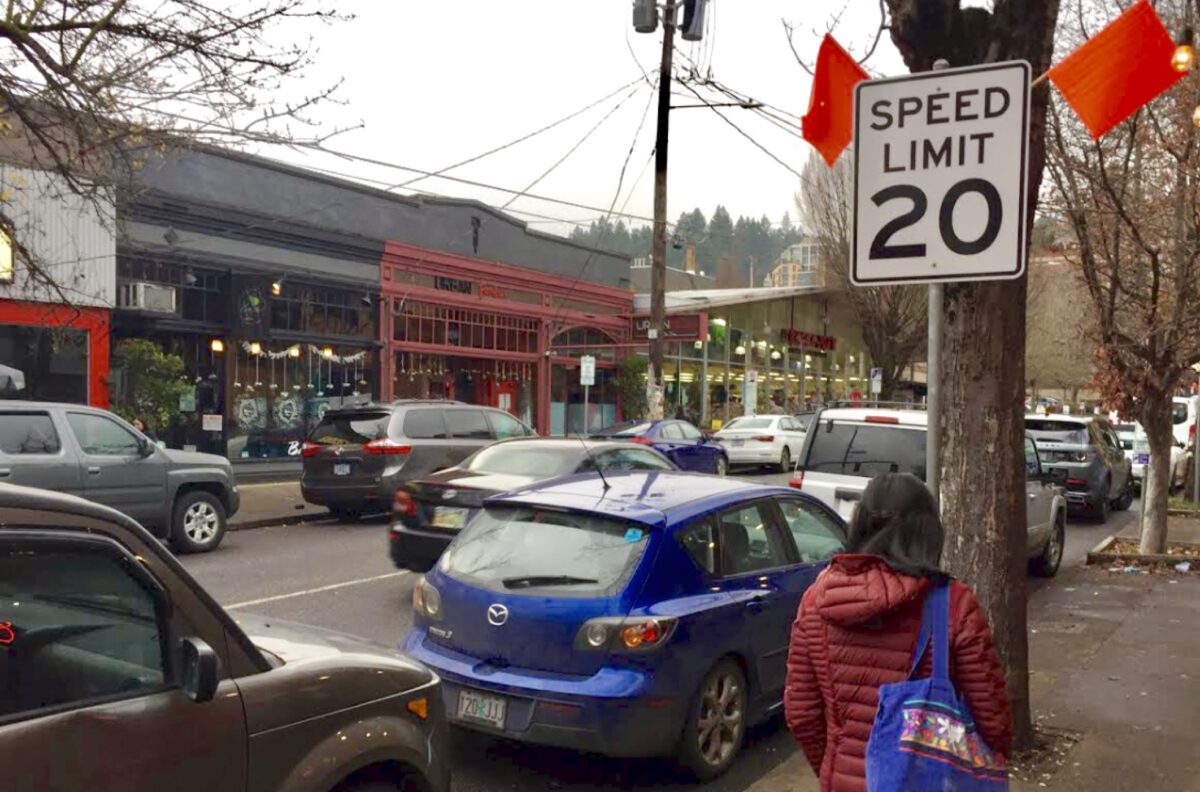
(Photo: Scott Kocher)
“These changes are more meaningful for the Vision Zero speed reduction efforts than the change in average speeding, given the link to crash severity for vulnerable road users.”
— Portland State University research team
The Portland Bureau of Transportation says they’ve moved the line in their war against speeding.
The agency partnered with Portland State University to analyze 58 locations (below) before and after the posted speed limit was changed from 25 mph to 20 mph. After crunching numbers from 214,220 data points, researchers concluded that, “the number of higher-speed vehicles have been reduced.” That’s good news, PBOT says, even though the average speed was “essentially unchanged” from 21.66 mph before the signs were installed, to 21.70 mph after.
Beyond average speeds, the study looked at three specific speed behaviors: exceeding 25, 30, and 35 mph. This is where the results are most significant. In each scenario there was a “substantial reduction” in people going over those thresholds. From the study: “Specifically, there was a 15.9% reduction in odds of observing speeds greater than 25 mi/hr, a 33.6% reduction in odds of observing speeds greater than 30 mi/hr, and a 49.6% in odds of observing speeds greater than 35 mi/hr.” Based on that data, researchers claimed the speed limit reduction, “significantly decreases the odds of observed high speeds.”

The location with the highest reduction of drivers going over 30 mph — a whopping 29% — was Northeast Ainsworth east of 10th. On the other end of the spectrum, the number of people driving over 30 mph after 20 mph speed limit signs were installed went up at 18 of the 58 locations (albeit only a very few).
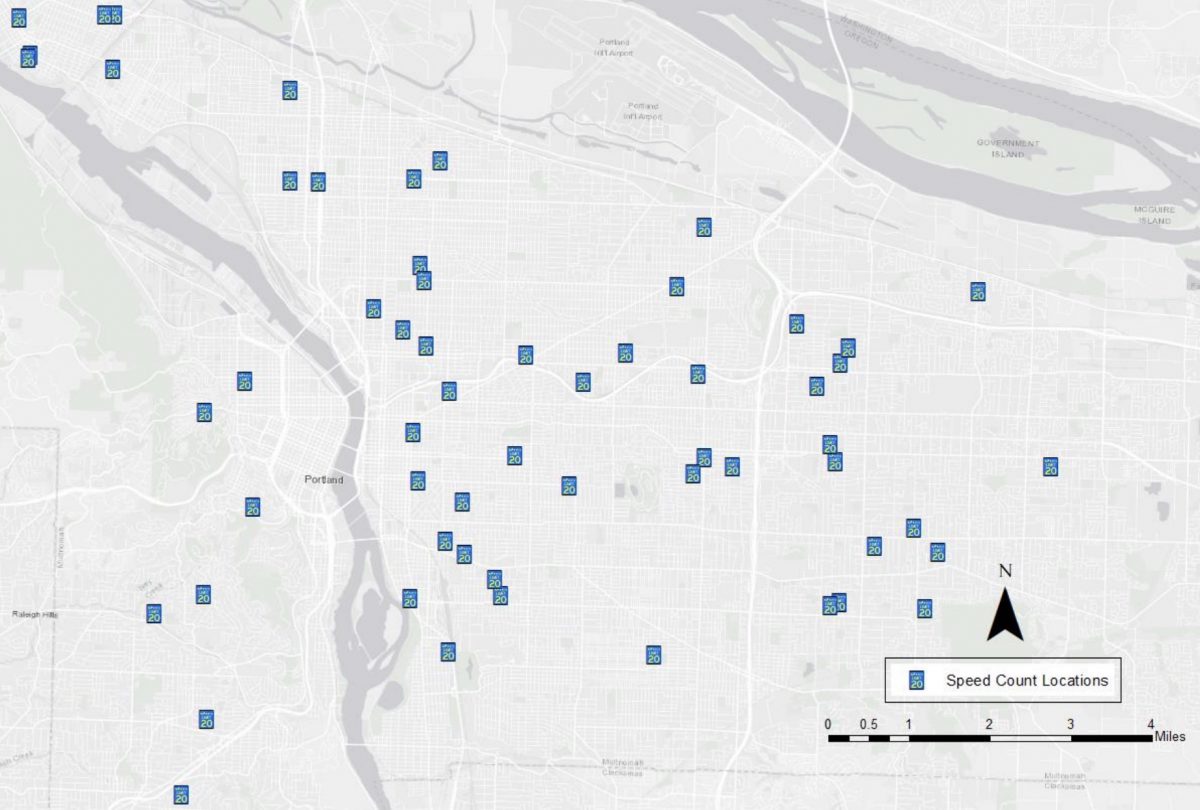
Advertisement
“These changes [in top-end speeding] are more meaningful for the Vision Zero speed reduction efforts than the change in average speeding, given the link to crash severity for vulnerable road users,” the researchers concluded.
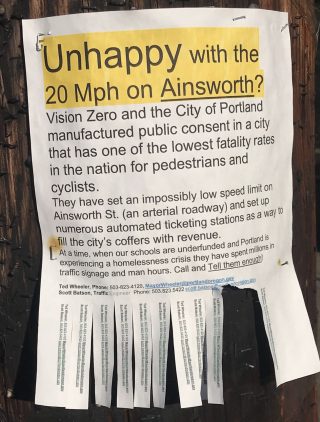
(Photo: Jonathan Maus/BikePortland)
PBOT echoed this sentiment in a statement about the report released today. They said while the average speed remained 22 mph across the 58 locations, the reduction in high speed drivers is a great result. Here’s more from PBOT’s statement:
“Given the powerful negative effect of higher speeds on safety, the National Association of City Transportation Officials recommends that speed limit evaluations heavily weigh ‘high-end’ speeds, or ‘the number or percent of drivers exceeding specific, high-risk speed thresholds,’ to accurately assess the safety impacts of speed limit changes.”
PBOT passed a “20 is Plenty” campaign at Portland City Council in January 2018 after getting it through the Oregon Legislature in the 2017 session. City crews have since blanketed 70% of Portland streets with 20 mph signs.
20 mph zones are just one front in PBOT’s war on speed. They have also lowered speed limits — from 35 to 30 mph, 30 to 25 mph, and so on — on dozens of street segments citywide since 2017. An analysis of those reductions is forthcoming. PBOT also operates eight automated speed cameras (at four intersections) that have had a major impact on slowing people down.
The report on 20 mph signs, Effect of Residential Street Speed Limit Reduction from 25 to 20 mi/hr on Driving Speeds in Portland, Oregon, was written by Jason C. Anderson, Ph.D., Chris Monsere, Ph.D., P.E., and Sirisha Kothuri, Ph.D from the PSU School of Civil & Environmental Engineering. Download it here.
— Jonathan Maus: (503) 706-8804, @jonathan_maus on Twitter and jonathan@bikeportland.org
— Get our headlines delivered to your inbox.
— Support this independent community media outlet with a one-time contribution or monthly subscription.


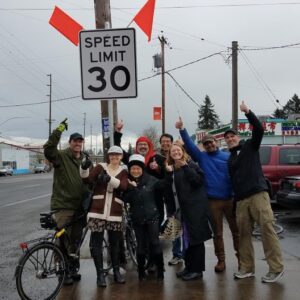

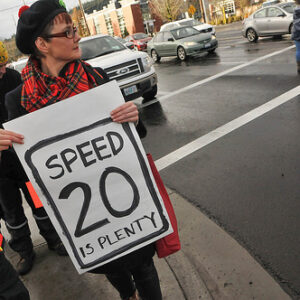

Thanks for reading.
BikePortland has served this community with independent community journalism since 2005. We rely on subscriptions from readers like you to survive. Your financial support is vital in keeping this valuable resource alive and well.
Please subscribe today to strengthen and expand our work.
I am so excited by this study. It is a serious piece of work.
If you like data, click on the report and find Appendix B, which has the Before and After Speed Distribution for each of the 58 study streets. Pick a street near you and see how those speeders in the right tail compress toward the mean.
If the stats in the middle of the report are too much, jump to the Conclusion. I particularly appreciated the last paragraph describing the “limitations to the analysis.” The authors point out the different durations over which the Before and After data were collected, and point out the possibility that the After data was collected before the full effect of the “20 is Plenty”program was reached.
To that I would add the effect of novelty. It’s possible that once the newness of the program wears off, that drivers revert to their old habits. That argues for changing up the signs, so that they continue to surprise.
I can’t wait to make a cup of tea and read the report but one question:
If top end speeding went down (yay!) but the average speed stayed the same (weird!) does that mean… “improved” traffic flow? Fewer people are driving very slowly and dragging down the average? Any ideas to explain that result?
Yeah, Scott, let me take a shot at it. The “Greater than” 25, 30 and 35 mph percentage changes are binary, in that you’ve either stayed in that category, or moved out of it. But they don’t say by how much. There’s no magnitude.
So imagine that all the over 35 mph drivers were going 36mph, “before.” “After” 20-is-plenty all of them reduce their speed to 35, and you have a 100% reduction out of the over 35 mph category. However, it hasn’t really reduced the mean speed by much. If a handful of the under 25 mph drivers increased their speed from 21 to 22, it would keep the mean the same.
I think. I may come back in an hour an be embarrassed by what I’ve written.
Meanwhile Portland will set twenty year highs for deaths on the road in both 2019 and probably 2020. Great work!
So, according to the “protest” sign this both a waste of money and a scheme to raise money.
The idea that anyone is getting speeding tickets in Portland is laughable.
Well, in this case, they are. I live off Ainsworth and the use of photo vans has caught a number of folks I know over the past year.
Oh. That’s good to hear. We need more fixed enforcement all over the city.
My dad’s main argument against lowering the speed limit is that people would still drive 10 over (yes, he’s telling on himself here). It’s great to see data that back up the hypothesis that they’d still reduce their speed. 😀 😀 😀
I wonder to what degree this is due to the fact that if one person decides to drive at the speed limit, everyone behind them is forced to as well? It’s not just your dad’s choices that influence how fast he drives. 🙂
In two-lane roads like most of NW, that’s probably a large factor. Maybe it’ll annoy faster drivers so much they’ll stay off of the slower streets and focus on the arterials? Or…learn to calm down and roll with it? In retirement my dad has actually realized he finds other drivers (and traffic laws) so annoying, he now prefers to ride the bus. If only others could have the time, access, and self-awareness to make similar decisions.
Interesting study. I have a few questions:
1) Were speed bumps or any diversionary infrastructure installed parallel to these signs at some locations, and how much of an effect did these have?
2) People in cars often recognize that a 20mph sign actually means one can drive 30mph without repercussion (ie 10mph over the speed limit). Given that the percentage of sites with a decrease are remarkably similar (ie 74, 69 and 72) regardless of posted speed, can the data suggest that lower the speed 5mph on signs has very little affect on the average driver?
3) Comparing the data to speed cameras, would one find a similar effect?
On N Fessenden, speed bumps and traffic islands have helped substantially slow the speed. There’s still people who will dodge the cuts in the speed bumps and zig-zag quickly through but even they have a very difficult time reaching the 40-45MPH that had been common speed before until a rash of pedestrian deaths led to this traffic calming action. I love it! It’s made our neighborhood more livable.
20 mph speed limits cannot be used on streets cameras can be used on, and vise-versa. you would be comparing two different kinds of street, context and traffic, an apples to turtles comparison, if you will.
Speeds go down and fatalities keep rising.
Clearly it’s not enough, but is it not possible that we could have seen more deaths without the reduction in speed?
Good point. In the hell of nextdoor.com, the mantra is that since deaths are not dropping after “20 is plenty”, all speed reductions are total failures.
Deaths staying the despite the proliferation of giant trucks trucks says otherwise.
I haven’t seen much evidence that the “proliferation of giant trucks” has been causing a whole lot of deaths on the types of streets that have had their speed limits reduced, so the lack of growth in that number doesn’t really say much at all.
Are those fatalities happening on these 20 mph streets or are they happening on the wider 35 mph+ streets? Guessing that it is the later, but haven’t compared the two data sets myself yet.
The vast majority occur on arterials.
That is correct. More specifically, arterial roads in East Portland. The city has spent a huge effort on reducing street speeds to 20 mph in parts of the city that already are among the safest in the city and calling it a success, but ignoring the fastest streets in the city where most deaths are still occurring. They are still studying the East Portland streets, but actually doing very little to reduce speeds. PBOT has a plan for outer Stark, but still no implementation, ditto with 122nd, Division, Halsey, 162nd, 148th, etc. But at least they have plans – oh yeah.
I have some data on that: of 48 non-suicide crashes that killed people walking or rolling (pedestrians) in Portland 2017-2019 two were on freeways, 32 were on arterials, 9 on collectors (4 of which should have been posted 20 MPH but weren’t), and 3 were on local streets. So, 32 of 48 were on arterials. That’s just pedestrian fatalities (and the numbers are preliminary–full report coming soon). I suspect a larger percentage of the crashes that killed people inside vehicles were on arterials. That’s our experience in NW at least. Most of the people killed or seriously injured in NW are walking or biking. In a 20 MPH slow zone, even with some speeding going on, the physics just aren’t there to kill a person inside a vehicle, most of the time.
Great data, please share your source when available.
That makes sense that speeds going down isn’t going to reduce deaths when the earlier speeds were too slow to cause deaths. I wonder how the new lower limit signs will affect injuries and close calls?
It’s like COVID, it’s not only the death statistics that are important.
In addition to the salient points already made about most fatalities occurring on higher speed arterials, I’d like to point out how motor vehicles have gotten much bigger and heavier over the past twenty years. The higher the impact point and the heavier the vehicle, the more dangerous it will be even at lower speeds.
If the speed cameras are so effective why don’t we have more of them?
Seems like a good option as no one could claim the camera is biased.
People will claim the person writing the tickets is biased.
Isn’t that crazy?! And then we will continue to have more traffic deaths which occur disproportionately in lower income/less expensive neighborhoods. Well, the world isn’t fair is it?
This conversation makes no sense.
Maybe I can help.
Pascual suggested installing more traffic cameras suggesting (naively) that people won’t complain about cameras being biased.
MOTRG (with a hint of snark) pointed out that people will still complain about bias (because the state of our world right now is that everything is biased), thus undermining their use.
Pascual then pointed out that the demographic groups who may be victims of enforcement bias are the same as those suffering disproportionately from traffic mayhem, so well-meaning efforts to protect certain groups of dangerous drivers is costing lives in those same groups. Pascual ends with a sardonic comment about the fairness of life, which I interpret in the same vein as telling those on the right that “reality has a strong liberal bias”, though targeted a bit to the left of where reality’s biases lie.
Does that clarify things?
That’s not what I got from this conversation. There is a lot of evidence to suggest implicit bias and disproportional force is used in policing. It’s very easy for a white guy to dismiss any effort to counter this through generic arguments such as “People will claim the person writing the tickets is biased,” without actually examining the issue. The argument becomes “being PC is dumb,” or “everyone is racist”, not “let’s examine how we can make the use of speed cameras less biased.” It is much easier to discount an argument on base sarcasm than it is to think critically.
Is is possible that both are true? That policing has some serious and intractable problems that demand attention, and that the current conversation has at times careened into the territory of the absurd?
Photo enforcement is limited by state law as to where it can be deployed. The mobile units have to be manned by a sworn officer and can locate on any road. The fixed cameras can only be on the most dangerous streets. ORS 810.442 states the rules. https://www.oregonlegislature.gov/bills_laws/ors/ors810.html
“Sec. 1. (1) As used in this section, “urban high crash corridor” means a segment of highway that has an incidence rate of reported traffic crashes resulting in fatalities or serious injuries that is at least 25 percent higher than the rate for highways with the same speed limit or designated speed within the jurisdiction on average between January 1, 2006, and January 1, 2016, and for which the governing body of the city makes a finding that speeding has had a negative impact on traffic safety.”
https://www.portland.gov/transportation/vision-zero/speed-cameras
https://www.portland.gov/police/divisions/photo-enforcement
There must be more places in Portland that fit the legal criteria for speed cameras. Why aren’t we using them more?
Agreed. Speed cameras are so effective at reducing speed and crashes, it’s silly to limit their use so extensively.
Ahh, no wonder those stats don’t corelate with the new reality of the streets today, the stats were collected from Feb – July 2019, well before COVID and the new non-enforcement reality of Portland.
I wonder what they’d find if they’d take the stats with the excessive speeding routinely happening on the those 20 – 25 MPH signed streets now?
As a non-scientific observer, just in my neighborhood, speeding and running stop signs is way up from pre-COVID / laws enforced days.
PBOT patting themselves on their backs is way pre-mature.
And just this morning on my morning walk a driver almost plowed into me as they were more interested in running a stop sign than seeing me crossing in the crosswalk. It’s not like I’m invisible, light colored clothing, reflective safety vest, and flashing LED light on chest.
Yeah PBOT, you keep telling us how much safer it is out there because you changed some signs on the streets . . . NOT!!!!
I’m a big fan of the 20 is Plenty plan, but Ainsworth makes little sense at 20 MPH. It does seem a bit arbitrary, especially considering that since they added the parallel Holman Greenway 1 block North (to go along with a very low-traffic biking option one block South) the usual bike v passing car conflicts have been reduced dramatically. Ainsworth is a narrow road due to tight on-street parking that makes it less than suitable to bike on regardless of the 20 MPH limit. It seems that riders have figured out that Holman is a much more pleasant biking experience.
If they are concerned about the (normally sparse) Alberta Park foot traffic, then they should probably consider putting in actual pedestrian crossings on Ainsworth at 21st and 22nd. That would seem to be the only spot of real concern on that stretch, but they haven’t.
The island in the road also allows pedestrians easy harbor when crossing, so that is another mitigating factor concerning safety. I guess my point is that at least some of us in the neighborhood had not considered Ainsworth to be a significant safety issue, so it was a surprise when the speed was dropped so low. There are other, more worthy streets in the area that did not see such drastically reduced speeds.
They should have split the difference at 25, it would better fit the neighborhood and not have needlessly irritated the locals.
I live near Ainsworth & appreciate the speed reduction a lot. Much more pleasant to walk and not annoying at all to drive 20 MPH.
Arbitrary is setting different speed limits to “fit” different neighborhoods. A consistent 20mph for all non-arterials is the opposite of arbitrary.
Residents seem to have misinterpreted and then advertised the PBOT vans that collected the speed data as “automated ticketing stations”. Then how do the researchers know that the impacts on top end speeds were not just due their obvious speed measurements being misinterpreted as enforcements. It was posted as such on the flyer above, and I’m betting ‘Nextdoor’ also.
Even if some neighbors knew the vans were just for speed measurement, it would still likely impact their driving behavior.
Speeds are usually measured using subtle tubes on the pavement, not “vans.” PBOT doesn’t even have vans, as far as I know, since they don’t do speed enforcement. The police do speed enforcement, though very rarely would they do so on a 20 mph street.
Vans don’t collect the data. the tubes on the road that are left for 48 hours do.
Hey, I have an idea for a study. Let’s see if there is any effect from ENFORCEMENT. We have lots of “before” data. Oh, wait, we can’t do that enforcement since it may impact some non-privileged people. Better get used to more vehicle killings.
Yep, since all enforcement is biased our only option is anarchy. Guess that is what the progressives want.
Do we think lower speed limits will affect future road design? I’m not really impressed with the magnitude of change documented here. Yes 23.6% is less than 24.1%, but… not much. You can only do so much with signs. However, if different expectations about acceptable speeds makes road engineers design these streets differently in the future (in say 20 years when they need to rebuild something), that’s really going to affect behavior.
I LOVE driving 20 mph –exactly– on NE Ainsworth St! Every driver counts for lowering speed limits! (BTW I’m also That Guy driving 55 mph on the highway–drive the speed limit everywhere!)